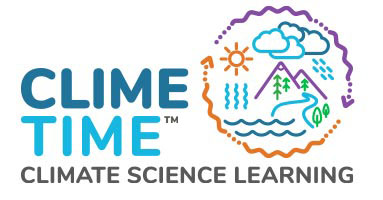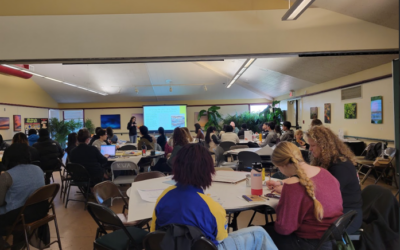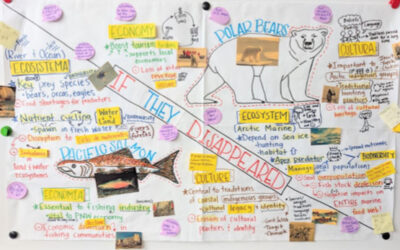The Earth Systems and Changes project brought together K-6 teachers from Southeast Washington to experience place based, local field experiences at the Coyote Canyon Mammoth Site to understand Earth systems, changes, and climate science in the context of natural and human impacts on Earth.
On September 30th teachers began their day at ESD 123 deepening their knowledge of the NGSS and 3-Dimensional teaching strategies while looking closely at volcanology, seismology, geochronology, and plate tectonics data to analyze changes that happen to Earth overtime.

Teacher’s are plotting and mapping the Earth as they dig
In the afternoon teacher traveled to the Coyote Canyon Mammoth Site where they learned about how mammoth bones were discovered in the Mid-Columbia – South Kennewick area. After reading research on mammoth life cycle, habitat, and local mammoth finds, teachers were then taught the process of how to set up a dig plot in the same manner that paleontologists use at the site to uncover mammoth bones and other evidence of what the earth was like in the time of the mammoths. Once the process was learned the teachers were taken to the dig site and set to work. Teachers measured a 1meter x 1meter plot then began mapping their findings. The next step was heading to the washing station where the soil is removed and the materials that remains are dried and sent to the picking station. At the picking station, teachers learn to separate insects, bones, rocks, and plants into separate categories. From this step the samples go to the microscopy station where the samples are photographed. All samples are used as data to provide a picture of what the Mid-Columbia might have looked like during the time of the mammoths.

Analyzing Earth Data
When teachers were asked about the impact of this field experience on their learning they said, “This class is amazing. I love expanding my understanding of local history and opportunities”. When then asked about how their learning will impact students a teacher said, “the training was great and a very memorable experience. I think that if I can incorporate some of the same strategies into my science lessons it will really help the kids to learn the lesson.”
In future meetings teachers will build on this experience to look further into climate change in Earth’s history and compare to current clime changes and in turn look at human impacts on climate change.




